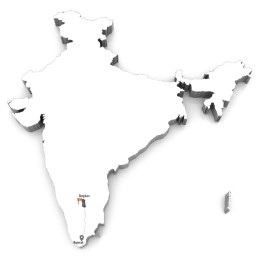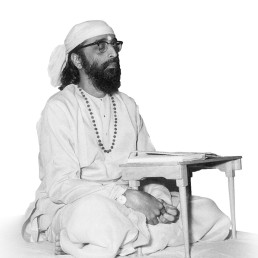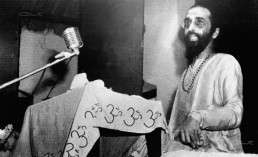
Jnana Yajna 103

Year & Dates:
April 23, 1962 to May 22, 1962

Yajna Topic:
Shrimad Bhagavad Gita- Chapter 17

Place:
Bengaluru, India
Bengaluru always ran into a pleasant quandary whenever Pujya Gurudev’s Jnana Yajnas were hosted. No matter how big the yajnashala enclosure, the crowds exceeded its capacity! So, as soon as Pujya Gurudev decided to conduct His 103rd Jnana Yajna in Bengaluru, a high-powered yajna committee was formed. Prominent businessmen and retired officials of the Karnataka government began planning. They were ably supported by an enthusiastic member body of the Chinmaya Mission (CM) branch in Bengaluru.To fund the various expenses related to that tenth yajna in the city, the different Study Groups reached out to patrons and donors.
After careful consideration, the humongous playgrounds of the Corporation High School at the Shivajinagar location in the city was chosen, and the largest Pandal thus far in the city arose. Surrounding it were the book stalls and the special CM counter. Flowers, bright streamers, and sparkling strings of colorful lights adorned the yajnashala that shone with great anticipation.
The Lamp of Love and Renunciation
Showing no signs of His travel fatigue and an aching back, Pujya Gurudev marched into the already-bustling yajnashala at precisely 6:30 pm on the evening of April 23, 1962. The Purna Kumbha reception amid the Vedic chants before the Om flag hoisting by Sri. S. M. Ramakrishna Rao, the president of the yajna committee, was apt and auspicious. Two proud rows of Balavihar children, chanting the Mahamantra and beautifying Pujya Gurudev’s path to stage with flowers, presented an endearing scene. And, Pujya Gurudev inaugurated the Jnana yajna with His three sonorous utterances of “Om” and a gripping introduction of the climactic chapter 17 of the Gita. He also gave the context of the Taittiriya Upanishad that would be the subject of His morning sessions.
Through Detachment (Tyaga) to “Renunciation” reiterated Pujya Gurudev as He explained Chapter 17: “Sanyasa means sacrifice, and to live in a spirit of sacrifice after renouncing completely one’s ego and its desires is true Sanyasa, wherein an individual comes to live in constant awareness of his fuller and ampler Divinity. Sanyasa is not running away from life or coloring the cloth. Hinduism considers him to be a Sanyasin who has learnt the art of living his life in constant inspiration which is gained through an intelligent renunciation of his ego-centric misconception.”
The audience multiplied as predicted, braving the rains, to sit at the Master’s Feet breathing in His dynamism and mesmerized by the way He summarized the entire Gita through His impassioned explanation, verse by verse. They were moved when He battled his own fever-ridden body to return to the stage after minimal rest for a day. He even accompanied them on a day’s yatra to the holy temple of Subramanya on May 15th.
Pujya Gurudev set aside time during the yajna to showcase the children of the many Bala Vihars in Bengaluru. The children came onstage to enchant all with their sweet and clear chanting of the Gita, Vishnu Sahasranama, and other stotras. Their stories and bhajans filled the audience with joy and devotion. Pujya Gurudev encouraged the budding talents with prizes and the invaluable, fatherly love of a Guru.
A Meditation Minute:
बालकेषु च संस्कारो विचारो युवकेषु च । धर्मनिष्ठा देशभक्तिः लोकसेवा तथैव च ॥६॥
bālakeṣu ca saṃskāro vicāro yuvakeṣu ca । dharmaniṣṭhā deśabhaktiḥ lokasevā tathaiva ca ॥6॥
- Noble saṃskāra among children and right thinking among youth and so also firm abidance in one’s duties, patriotism and service of people.
We surrender with adoration and reverence to our Pujya Gurudev who brightened the hearts of millions of children with His immeasurable love. His unbridled joy and laughter with the most innocent young, His straightforward nobility that captured the attention of the youth, and His resolute seva to Bhaarata and the people worldwide is the happiest legacy of Chinmaya Mission.
Photo Gallery

“Think,” Says Pujya Gurudev
To the extent we identify with him to that extent His light and power comes to be ours which is called His grace (Prasad). Ere long a result of this accumulated “grace” brought within, through the integration of the personality and a constant surrender of the ego, the individual shall obtain “the Supreme peace, the eternal resting place”.
With one’s all being (Sarvabhavena) : This surrender unto the Lord should not be a temporary self-deception. We must grow into a consciousness of the presence of the divine in all the planes of our existence. To illustrate such an all-out devotion, we have the examples of Radha, Hanuman, Prahlaada and others. Without bringing all the levels of our being and all the facets of our personality into our love for Him, we cannot drown our finite ego-sense into the joyous lap of the Infinite Lord. Thus, a true devotee must change the entire orientation of his being, and most surrender himself as a willing vehicle for His expressions. Then and alone, all the delusions end and the mortal gains the experience and lives the State of Immortality the Godhood.
From Tyagi Magazine
Question:- Your Holiness never tells us anything about your life at Uttarkasi where you had been for more than ten years. This will surely inspire at least write about it in the Usha; it will benefit all of us.
By old association, too sacred for words, Uttarkashi life is a theme I cannot speak on or write about. I still find in it a leisurely charm against which all my hurried dashes from place to place, breathless talking, hurried achievements, busy success- all look like a morbid fever of an imprisoned heart. I thus suffer but I am happy too that I suffer! This walkie-talkie phase of my life is full of thrills of sobs, sweet with disappointments and bitter with satisfactions.
Question:- Can we practice Karma Yoga while living our-every-day life? Then why is it called Yoga? What is Karma Yoga please
While walking the rugged grandeur of our every-day-life, let us live the flaming joy of His Peace in our hearts. Surrender to Him in devotion, and work. This is karma Yoga.
Remember this, before you donate!
What intricate dynamics underlie charity, transitioning from selfless Sattvic giving to reluctant Rajasic acts and misguided Tamasic gestures? How can one unlock the transformative potential by aligning actions with higher ideals, paving the way for deeper altruistic fulfillment and personal growth?
Watch video and learn.

